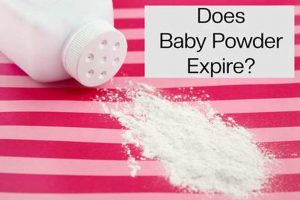Regurgitation through the nasal passages in infants, often observed after feeding, involves the flow of ingested liquid from the stomach, up the esophagus, and exiting via the nostrils. This phenomenon is generally related to the developing anatomy and physiology of the upper digestive and respiratory systems in newborns. For example, a baby who has just finished a bottle might exhibit this, especially if they were fed quickly or laid down immediately afterward.
Understanding this occurrence is important for caregivers and medical professionals, as it can indicate various underlying factors. While frequently benign and self-limiting, persistent or forceful regurgitation warrants investigation to rule out potential issues such as gastroesophageal reflux or anatomical abnormalities. Historically, variations in infant feeding techniques and positioning have been employed to mitigate this common issue.
The subsequent discussion will delve into the potential causes, management strategies, and warning signs associated with this condition. It will also address preventative measures and when seeking professional medical advice is necessary.
Mitigating Nasal Regurgitation in Infants
The following guidance addresses measures designed to minimize instances of liquid expulsion through the nasal passages in infants following feeding.
Tip 1: Employ Upright Feeding Positions: Maintaining the infant in a semi-upright posture during feeding sessions can reduce the likelihood of backflow. Gravity assists in keeping ingested fluids within the stomach.
Tip 2: Implement Frequent Burping: Interrupt feeding at regular intervals to burp the infant. This practice helps release trapped air, decreasing abdominal pressure and potential upward movement of stomach contents.
Tip 3: Reduce Feeding Speed: Slower feeding paces minimize the volume of air ingested alongside milk or formula. Bottle-feeding infants should be offered nipples with appropriate flow rates.
Tip 4: Post-Feeding Positioning: Keeping the infant in an elevated position for approximately 30 minutes after feeding may aid in settling stomach contents. Avoid placing the infant in a completely flat position immediately after feeding.
Tip 5: Consider Smaller, More Frequent Feeds: Dividing the daily feeding volume into smaller, more frequent administrations can reduce the burden on the infant’s digestive system and limit regurgitation.
Tip 6: Formula Adjustments (If Applicable): In formula-fed infants, consultation with a pediatrician regarding formula type may be beneficial. Certain formulas are designed to be easier to digest and may reduce regurgitation frequency.
Tip 7: Observe for Potential Underlying Conditions: If nasal regurgitation is persistent, forceful, or accompanied by other symptoms such as poor weight gain or respiratory distress, seek professional medical evaluation to rule out underlying medical conditions.
Adhering to these recommendations aims to optimize infant feeding practices and minimize the occurrence of liquid expulsion via the nasal passages.
The subsequent section will address scenarios necessitating immediate medical attention and further diagnostic investigation.
1. Regurgitation versus vomiting
The distinction between regurgitation and vomiting is critical when addressing the presence of milk exiting an infant’s nasal passages. Regurgitation, often termed “spitting up,” represents the effortless backflow of stomach contents. This passive process is usually attributable to the immaturity of the lower esophageal sphincter, the muscle that prevents stomach contents from flowing back into the esophagus. Consequently, milk may easily travel upward and, due to the connection between the nasal passages and the back of the throat, exit through the nose. An example of regurgitation is when a baby, after a feed, calmly expels a small amount of milk without any apparent distress.
In contrast, vomiting is characterized by a forceful expulsion of stomach contents. It is an active process involving the contraction of abdominal muscles and often indicates an underlying issue such as an infection, allergy, or anatomical obstruction. When vomiting occurs, the pressure generated can also force milk through the nasal passages. A real-world example of vomiting would be if a baby experiences projectile expulsion of milk, accompanied by signs of discomfort such as arching their back or crying intensely.
Understanding the differentiation between these two processes is paramount for accurate assessment and management. While regurgitation is typically benign and resolves with time as the infant’s digestive system matures, vomiting warrants further investigation to identify and address the underlying cause. The presence of milk in the nasal passages, therefore, requires careful evaluation to determine whether it is a result of routine regurgitation or a symptom of a more serious medical condition triggering vomiting. Determining which one it is will help better manage the case.
2. Esophageal sphincter immaturity
Esophageal sphincter immaturity plays a significant role in the occurrence of milk exiting an infant’s nasal passages. The lower esophageal sphincter (LES), a ring of muscle located at the junction of the esophagus and stomach, is not fully developed in early infancy. This incomplete development contributes to the common phenomenon of milk traveling upward after feeding.
- Reduced Sphincter Tone
The LES in infants often exhibits reduced tone, meaning it doesn’t contract as tightly as it should. This weakness allows stomach contents, including milk, to reflux back into the esophagus more easily. Because infants spend a considerable amount of time lying down, gravity does not assist in keeping the contents within the stomach. An instance of this is an infant who immediately after being laid down expels milk through their nose, showcasing how the relaxed sphincter combines with position to facilitate regurgitation.
- Shorter Esophageal Length
Infants have a shorter esophagus than adults, which reduces the distance milk must travel to reach the mouth or nasal passages. This proximity increases the likelihood of regurgitation. If the LES relaxes, the milk has a shorter and easier route to travel back up the throat and out the nose. A real example involves an infant who has frequent episodes of nasal regurgitation despite normal feeding practices, potentially due to their shorter esophageal length in conjunction with LES immaturity.
- Increased Abdominal Pressure
Factors such as overfeeding or excessive gas can increase intra-abdominal pressure in infants. This elevated pressure can overcome the weak LES, forcing stomach contents upward. A baby who is fed large volumes of milk in a short time is more prone to nasal milk expulsion, because the stomach gets full to the point of causing the fluid to travel through any opening, like the throat and nose, due to abdominal pressure.
- Patent Nasopharyngeal Connection
The nasopharynx, the upper part of the throat behind the nose, is directly connected to the nasal passages. When milk refluxes into the esophagus, it can easily flow into the nasopharynx and exit through the nostrils. Consider a scenario where an infant with a developing LES experiences reflux; the milk encounters minimal resistance in entering the nasal cavity, resulting in nasal discharge. This anatomical factor explains how even small amounts of regurgitated milk can appear via the nose.
In summation, milk exiting an infant’s nasal passages is frequently linked to the immaturity of the lower esophageal sphincter, which predisposes them to reflux. The interplay of reduced sphincter tone, shortened esophageal length, and increased abdominal pressure, combined with the direct connection between the nasopharynx and nasal passages, contributes to this common pediatric presentation.
3. Feeding technique evaluation
Effective assessment of feeding techniques is paramount when addressing instances of milk expulsion through an infant’s nasal passages. Improper feeding practices can exacerbate or contribute to this issue, underscoring the need for a detailed evaluation to identify and rectify potential problems.
- Bottle Nipple Flow Rate
The flow rate of the bottle nipple significantly influences milk ingestion speed. A nipple with an excessively fast flow can overwhelm the infant’s ability to coordinate swallowing and breathing, leading to gulping and subsequent regurgitation. Milk may then be forced into the nasal passages due to the pressure. For example, an infant using a nipple intended for older babies might experience milk expulsion through the nose due to the rapid intake exceeding their swallowing capacity. The implications include not only nasal regurgitation but also potential choking hazards.
- Infant Positioning During Feeds
The position in which an infant is held during feeding impacts the risk of milk reflux. A fully reclined position can compromise the closure of the lower esophageal sphincter, facilitating the backflow of stomach contents. Holding the infant in a more upright or semi-upright position can help utilize gravity to keep milk in the stomach. An infant consistently fed lying flat on their back is more likely to exhibit nasal milk expulsion than one held at a 45-degree angle during feeding. The ramifications are that improper positioning can negate other preventative measures.
- Frequency and Volume of Feeds
Overfeeding or providing excessively large volumes of milk in a single feeding session can overwhelm the infant’s digestive capacity. An overfull stomach increases pressure, making regurgitation more likely. Smaller, more frequent feedings can reduce this pressure and mitigate the risk of milk entering the nasal passages. An infant given a large bottle every few hours, instead of smaller amounts more frequently, may experience increased nasal regurgitation. This highlights the critical link between feeding management and infant comfort.
- Burping Technique and Frequency
The effectiveness and regularity of burping can affect intra-abdominal pressure. Trapped air in the stomach can contribute to increased pressure, predisposing the infant to regurgitation. Regular burping during and after feeds helps release trapped air, reducing pressure and minimizing the chance of milk backflow. An infant who is not burped adequately during and after feedings may experience greater instances of milk being forced through their nose due to the internal pressure from accumulated gas. Consistent burping thus acts as a preventative measure.
In summary, the evaluation of feeding techniques is a crucial step in managing milk expulsion through an infant’s nasal passages. Correcting issues related to nipple flow, positioning, feeding volume, and burping frequency can significantly reduce the occurrence of this phenomenon and improve infant comfort and well-being. Recognizing and addressing these factors is essential for both parents and healthcare providers.
4. Positional influence assessed
The assessment of positional influence is a critical component in understanding instances of milk exiting an infant’s nasal passages. The gravitational forces acting on the infant’s digestive system are directly affected by their body position, influencing the likelihood of gastroesophageal reflux and subsequent nasal expulsion. For example, an infant lying supine after feeding experiences reduced gravitational assistance in retaining stomach contents, increasing the potential for upward migration of milk through the esophagus and into the nasal passages. This is particularly relevant given the relatively short esophagus and immature lower esophageal sphincter characteristic of infants.
Practical application of positional assessment involves careful consideration of infant positioning both during and after feeding. Semi-upright positions during feeding leverage gravity to promote downward flow, reducing the risk of reflux. Similarly, maintaining an elevated head position for a period following feeding aids in the settling of stomach contents. Conversely, positioning an infant in a car seat or swing immediately post-feeding, where the torso is often compressed, can increase intra-abdominal pressure, potentially exacerbating reflux and the associated nasal milk expulsion. These examples highlight the direct correlation between postural management and the minimization of this phenomenon.
In summary, the assessment and management of positional influence is a practical, non-invasive strategy for mitigating milk expulsion through an infant’s nasal passages. While positional modifications alone may not eliminate the issue entirely, particularly in infants with underlying gastroesophageal reflux, they represent a fundamental aspect of infant care and feeding practices. Recognizing and addressing positional factors can significantly contribute to reducing the frequency and severity of nasal milk expulsion, enhancing infant comfort and parental reassurance.
5. Underlying causes considered
Evaluation for potential underlying medical conditions is paramount when addressing instances of milk exiting an infants nasal passages. While often attributable to transient physiological immaturity, persistent or severe regurgitation warrants thorough investigation to rule out less common but clinically significant etiologies.
- Gastroesophageal Reflux Disease (GERD)
GERD, distinct from normal infant reflux, involves frequent and troublesome symptoms or complications arising from gastric content reflux. In the context of nasal milk expulsion, GERD may manifest as persistent, forceful regurgitation that overwhelms the infant’s protective mechanisms. A practical example involves an infant exhibiting poor weight gain, irritability, and frequent nasal regurgitation, despite appropriate feeding techniques. Diagnostic studies, such as a pH probe or upper endoscopy, may be warranted to confirm GERD and guide management. Failure to recognize and treat GERD can lead to esophagitis, respiratory complications, and feeding difficulties.
- Pyloric Stenosis
Pyloric stenosis, characterized by hypertrophy of the pyloric muscle, results in progressive gastric outlet obstruction. This condition typically presents with projectile vomiting, which can also manifest as milk expulsion through the nasal passages due to the force of expulsion and increased intragastric pressure. A common presentation involves an infant, usually between 2 and 12 weeks of age, exhibiting increasingly forceful vomiting after feedings. Palpation of an “olive-like” mass in the abdomen may aid in diagnosis, which is typically confirmed by ultrasound. Surgical correction is required, and delayed diagnosis can lead to dehydration and metabolic abnormalities.
- Milk Protein Allergy/Intolerance
Allergic or intolerant reactions to milk proteins can cause gastrointestinal inflammation and dysmotility, contributing to regurgitation and vomiting. Milk protein-induced proctocolitis, for instance, can manifest with bloody stools and increased reflux symptoms. In the setting of nasal milk expulsion, an infant with a suspected milk protein allergy may exhibit additional symptoms such as eczema, diarrhea, or fussiness. Diagnostic evaluation involves dietary elimination trials and, in some cases, endoscopy with biopsy. Dietary modifications, such as switching to a hypoallergenic formula, are essential for management.
- Anatomical Abnormalities
Less frequently, anatomical abnormalities, such as hiatal hernia or esophageal strictures, may contribute to regurgitation and nasal milk expulsion. These structural issues can impair normal esophageal function and increase the likelihood of reflux. Infants with such abnormalities may exhibit persistent regurgitation despite optimal feeding practices. Diagnostic studies, including upper gastrointestinal series or endoscopy, are necessary to identify and characterize these conditions. Management strategies vary depending on the specific abnormality and may involve medical or surgical interventions.
In conclusion, while physiological reflux is common in infancy, the evaluation for underlying causes is critical when nasal milk expulsion is persistent, severe, or associated with other concerning symptoms. Prompt recognition and management of conditions such as GERD, pyloric stenosis, milk protein allergy, or anatomical abnormalities are essential to ensure optimal infant health and prevent potential complications.
6. Aspiration risk awareness
The phenomenon of milk exiting an infant’s nasal passages carries a direct correlation with the risk of aspiration. Aspiration, the inhalation of fluids or solids into the lungs, is a significant concern due to the potential for respiratory complications, including pneumonia or airway obstruction. When milk regurgitates through the nose, it indicates that the infant’s protective reflexes, such as coughing and swallowing, may be overwhelmed, increasing the likelihood that the fluid could be inadvertently inhaled into the respiratory tract. An infant with an immature or uncoordinated swallow reflex is at higher risk when nasal regurgitation occurs. If the infant is unable to effectively clear the milk from the airway, it may enter the lungs. This can manifest as coughing, choking, or, in severe cases, cyanosis (bluish discoloration of the skin due to oxygen deprivation). The practical significance is that caregivers must be acutely aware of the potential for aspiration and respond appropriately to mitigate this risk.
Mitigation strategies for aspiration risk in cases of nasal milk expulsion involve careful positioning of the infant. Holding the infant upright during and after feeding can help prevent reflux and reduce the likelihood of fluid entering the nasal passages. If milk does exit the nose, immediately turning the infant to the side or stomach can help facilitate drainage and prevent aspiration. Furthermore, caregivers must be vigilant in monitoring the infant for signs of respiratory distress, such as rapid breathing, wheezing, or persistent coughing. The application of these strategies depends on a clear understanding of the aspiration risk associated with nasal milk regurgitation and the implementation of proactive measures to safeguard the infant’s airway. This heightened awareness allows for timely interventions and prompt medical attention if needed.
In conclusion, the connection between aspiration risk awareness and milk exiting an infant’s nasal passages underscores the importance of vigilance and preparedness in infant care. Recognizing the potential for respiratory complications, implementing appropriate positioning techniques, and diligently monitoring for signs of aspiration are essential for ensuring infant safety. Although nasal regurgitation is often a benign occurrence, the potential for aspiration necessitates a proactive approach to minimize risk and promote healthy respiratory function. It also highlights the need for continuous education and support for caregivers to effectively manage this common infant phenomenon.
7. Weight gain monitoring
Consistent monitoring of an infant’s weight is critical, particularly when there are instances of milk exiting through the nasal passages. Weight gain, or lack thereof, provides essential insights into whether the infant is receiving and retaining adequate nutrition, despite the observed regurgitation. Deviations from expected growth patterns necessitate further investigation.
- Indicator of Nutritional Adequacy
Regular weight checks serve as a primary indicator of whether the infant is receiving sufficient calories to support growth and development. Adequate weight gain, despite nasal milk expulsion, suggests that the regurgitation is not significantly impacting nutrient absorption. For example, if an infant gains weight within the expected percentile range despite frequent nasal regurgitation, it may indicate that the regurgitation is mild and self-limiting. Conversely, faltering weight gain warrants immediate attention and may necessitate interventions, such as altering feeding strategies or investigating potential underlying medical conditions.
- Reflection of Caloric Loss
Significant or persistent nasal milk expulsion can lead to substantial caloric loss, potentially impacting weight gain. Monitoring weight patterns helps quantify the impact of regurgitation on overall nutritional status. If an infant’s weight plateaus or declines in conjunction with nasal milk expulsion, it suggests that the caloric loss is outweighing the caloric intake. This scenario requires prompt intervention to prevent malnutrition and ensure appropriate growth. An instance of this is the need to switch to a higher-calorie formula.
- Guidance for Intervention Strategies
Weight gain data informs the selection and adjustment of intervention strategies aimed at mitigating nasal milk expulsion and optimizing nutritional intake. A steady weight gain trajectory may support a conservative approach, focusing on positional adjustments and feeding technique modifications. Conversely, inadequate weight gain may necessitate more aggressive interventions, such as medication to reduce acid reflux or dietary modifications to address potential allergies or intolerances. For instance, the implementation of thickened feeds may be considered in infants with poor weight gain and frequent regurgitation, while closely monitoring for potential side effects. Thus, weight checks drive decisions.
- Differentiation of Physiological vs. Pathological Regurgitation
Consistent weight gain assists in differentiating between normal physiological regurgitation and pathological regurgitation associated with underlying medical conditions. Infants with normal physiological regurgitation typically exhibit appropriate weight gain, while those with pathological regurgitation may demonstrate poor growth. This differentiation is crucial for guiding diagnostic and management decisions. A baby is considered to likely have physiological regurgitation if there is frequent regurgitation of milk through the nose but otherwise gaining weight normally.
In conclusion, weight gain monitoring is an indispensable tool in the management of infants experiencing milk expulsion through their nasal passages. It provides essential data for assessing nutritional adequacy, guiding intervention strategies, and differentiating between physiological and pathological regurgitation. Regular weight checks, in conjunction with a comprehensive evaluation of feeding practices and associated symptoms, are crucial for ensuring optimal infant health and well-being.
Frequently Asked Questions
The following questions and answers address common parental concerns related to the observation of milk exiting an infant’s nasal passages, providing factual information and practical guidance.
Question 1: Is milk exiting an infant’s nose always a cause for immediate concern?
While unsettling, the observation of milk exiting an infant’s nasal passages is frequently a benign occurrence related to the immaturity of the lower esophageal sphincter. However, persistent or forceful regurgitation, particularly when accompanied by other symptoms, warrants medical evaluation.
Question 2: What is the primary reason milk comes out of a baby’s nose after feeding?
The primary reason is typically the incomplete development of the lower esophageal sphincter (LES), the muscle that prevents stomach contents from flowing back into the esophagus. This immaturity allows milk to reflux easily, sometimes exiting through the nasal passages due to their connection with the throat.
Question 3: How can feeding techniques contribute to milk exiting an infant’s nose?
Inappropriate feeding techniques, such as using a bottle nipple with too rapid a flow rate, overfeeding, or failing to burp the infant adequately, can exacerbate milk expulsion through the nose. These practices increase the likelihood of reflux and subsequent nasal discharge.
Question 4: What are some strategies to reduce the frequency of milk exiting an infant’s nose?
Strategies include holding the infant in a semi-upright position during and after feeding, ensuring appropriate nipple flow rate, burping frequently, and providing smaller, more frequent meals. These measures can help minimize reflux and the associated nasal expulsion of milk.
Question 5: When should a medical professional be consulted regarding milk exiting an infant’s nose?
A medical professional should be consulted if the regurgitation is forceful, persistent, or accompanied by symptoms such as poor weight gain, respiratory distress (coughing, wheezing), excessive irritability, or blood in the regurgitated milk. These signs may indicate an underlying medical condition requiring intervention.
Question 6: Can milk exiting an infant’s nose lead to complications, and if so, what are they?
While typically benign, milk expulsion through the nose carries a risk of aspiration, the inhalation of fluid into the lungs, potentially leading to pneumonia or airway obstruction. Additionally, persistent reflux can contribute to esophagitis or feeding difficulties.
In summary, the occasional observation of milk exiting an infant’s nasal passages is often a normal occurrence. However, persistent or concerning symptoms necessitate medical evaluation to rule out underlying conditions and ensure optimal infant health.
The following section will address preventative measures and scenarios necessitating immediate medical attention.
Conclusion
The multifaceted exploration of instances of “milk coming out baby nose” reveals a common, yet nuanced, pediatric phenomenon. While often a benign manifestation of infant physiology, specifically related to esophageal sphincter immaturity, this occurrence necessitates a careful evaluation of feeding techniques, positional influences, and potential underlying medical conditions. Differentiating between normal regurgitation and pathological reflux, and understanding associated risks such as aspiration, are crucial for effective management.
Continued vigilance in monitoring infant weight gain, coupled with prompt medical consultation when warranted, remains paramount. This proactive approach ensures optimal infant health and minimizes potential complications. Further research into preventative strategies and long-term implications is encouraged to enhance our understanding and improve care practices.



![Kat Timpf Baby: Due Date Rumors & Facts [Babies News] Baby Care 101: Essential Tips for Happy, Healthy Babies Kat Timpf Baby: Due Date Rumors & Facts [Babies News] | Baby Care 101: Essential Tips for Happy, Healthy Babies](https://singlebabies.com/wp-content/uploads/2025/11/th-891-300x200.jpg)



